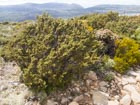
A mature plant in the alpine scrub at Mount Field National Park, Tasmania [C. J. Earle, 2015.02.27].
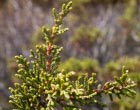
Terminal shoot of a plant in habitat, Mount Field National Park, Tasmania [C. J. Earle, 2015.02.27].
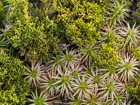
Pherosphaera and Richea at Mount Field National Park, Tasmania [C. J. Earle, 2015.02.27].
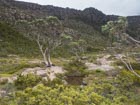
Shrubland locally dominated by Pherosphaera and Diselma in a Eucalyptus coccifera woodland; Mount Field National Park, Tasmania [C. J. Earle, 2015.02.27].
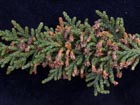
Detail of a shoot bearing the remains of female cones; Cradle Mountain National Park, Tasmania [C. J. Earle, 2015.03.04].
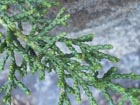
Shoot detail on a plant at the Royal Tasmanian Botanical Gardens, Tasmania [C. J. Earle, 2015.03.08].
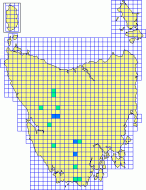
Distribution map (Brown et al. 1983). The side of each square measures 10 km. A blue square indicates arboretum collections; a green square denotes a written record. You can also create a highly detailed map, and access specimen data, using the "search" function at the Australia Virtual Herbarium.

Conservation Status

Pherosphaera hookeriana
W. Archer bis ex Hooker 1850
Common names
Drooping pine (DPIW 2009), Mt. Mawson pine (Farjon 2010).
Taxonomic notes
Syn: Dacrydium hookeriana (W. Archer bis) Eichl. 1887, and several invalidly published names: Microstrobos hookeriana (W. Archer bis) S. Archang. & G. Del Fueyo 1989, Microstrobos niphophilus J. Garden & L.A.S. Johnson 1951, Pherosphaera niphophila (J. Garden & L.A.S. Johnson) Florin 1956 (Brummitt et al. 2004). Type location Lake St. Clair, Tasmania, where collected by R.C. Gunn on 1841.01.07 (Hill 1998).
Description
Erect shrubs to 2.5 m tall, densely branched. Bark brown weathering dark gray, rough, exfoliating in small scaly plates. Branches spreading, contorted, dividing repeatedly to form twigs 1-1.5 mm diameter that form dense, stiff tufts of foliage. Leaves yellow-green, scale-like, spirally arranged; in seedlings and young plants 2-2.5 × 1 mm, largely free, incurved; in older plants smaller (mostly 1 × 1 mm, larger on thicker twigs and in whip shoots), imbricate, closely appressed; stomata on inner surfaces. Pollen cones numerous, terminal, globose, 2 mm diameter, red-brown. Seeds c. 1 mm diameter. Seed cones terminal on down-curved twigs, globose, 3-4 mm diameter, composed of 5-8 spreading ovate concave scales with an acute apex; brown at maturity. Usually 1-4 mature seeds per cone, solitary and basal on interior side of a scale, 1.3 × 1 mm, brown (Farjon 2010).
This species grows with and resembles Diselma archeri and Microcachrys tetragona. See Diselma for a table that assists in distinguishing these species.
Distribution and Ecology
Australia: Tasmania, locally abundant at mesic sites in subalpine areas in the west, southwest and on the central plateau, usually at elevations above 1000 m (Hill 1998). Frequent in wet moors and common in the riparian zone of lakes (Farjon 2010). Based on data from 26 collection localities, its climate preferences include a mean annual temperature of 7.5°C, with an average minimum in the coldest month of 0.1°C, and a mean annual precipitation of 1613 mm (Biffin et al. 2011, Table S5). There is no dry season, nor any extended period of snow cover. Bedrock is mostly acidic and surface and groundwater in these areas has a pH of 4.5 to 5 on average. Common associates include Athrotaxis cupressoides, Microcachrys tetragona, and on somewhat drier sites, Diselma archeri (Farjon 2010). Hardy to Zone 8 (cold hardiness limit between -12.1°C and -6.7°C) (Bannister and Neuner 2001).
Remarkable Specimens
No data as of 2023.02.21.
Ethnobotany
Rarely seen in cultivation, though probably a suitable candidate for rock gardens or as a pot plant.
Observations
Collections are reported from Mt. Field National Park, Lake St. Clair, and Eagle Tarn, among other places.
Remarks
The epithet remembers Joseph Dalton Hooker (1817-1911), the second Director of the Royal Botanic Gardens, Kew (Farjon 2010).
Citations
Brown, M.J., J.B. Kirkpatrick and A. Moscal. 1983. An atlas of Tasmania's endemic flora. Tasmania Conservation Trust, 102, Bathurst Street, Hobart 7000, Tasmania. 110 pp. ISBN 0959981683.
Garden, J. and L. A. S. Johnson. 1951. Microstrobos, a new name for a Podocarpaceous genus. Contr. New South Wales Natl. Herb. 1:315-317.
Hooker. 1850. Hooker's J. Bot. Kew Gard. Misc. 2:52.
See also







